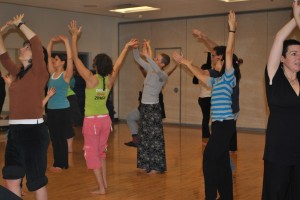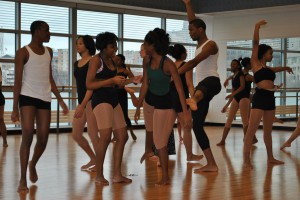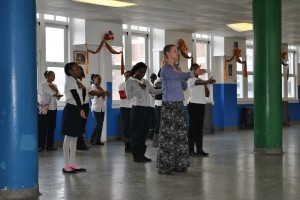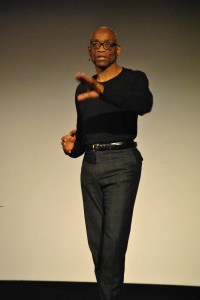Behind the Scenes: University of Michigan Students Perform with New York Philharmonic
As part of the UMS residency with New York Philharmonic, Jamie and Jessica, students from the U-M School of Music, Theatre & Dance, performed on stage with the orchestra at Hill Auditorium.
Go behind-the-scenes from audition to performance in this video.
Learn more about the 2017-18 season concerts and residency experience.
Behind the Scenes: 2017 New York Philharmonic Visit in Photos
As part of the 2017-18 UMS season, the New York Philharmonic visited Ann Arbor for three concerts and many educational residency activities in November 2017. Here are some of our favorite photos captured during the residency.
- NY PHIL Off The Grid pop-up chamber concerts took place downtown Ann Arbor at Fred’s and Avalon.
- Percussion musicians at Fred’s.
- In the audience.
- Musicians at Avalon.
- In the audience.
- Hill Auditorium, lit up for the concerts.
- New York Philharmonic on stage.
- U-M president Mark Schlissel and UMS president Matthew VanBesien speak from the stage.
- Students at U-M School of Music, Theatre & Dance await master classes with musicians from the New York Philharmonic.
- At a master class.
- Conversation between UMS president Matthew VanBesien and New York Philharmonic President Deborah Borda at the Ross School of Business.
- Leondard Slatkin and Barbara Haws during a pre-concert lecture.
- A full house during a pre-concert lecture.
- Kids learn more New York Philharmonic musicians before the concert recreating Leonard Bernstein’s Young People’s Concerts.
- Mark Schlissel, Leonard Slatkin, Matthew VanBesien, Jeremy Irons, and Rosie Jowitt at the Victors for the Arts gala.
- String quartet at the Victors for the Arts gala.
- At the Victors for the Arts gala.
- Leonard Slatkin at the final concert of the residency.
- Jeremy Irons narrates Leonard Bernstein’s “Kaddish” Symphony at the final concert of the residency.
Learn more and the New York Philharmonic concerts and residency experience.
The Lost Art of Writing Love Letters
Observations from Kyle Abraham’s Residency work with Michigan LGBTQ Youth

Choreographer Kyle Abraham. Photo courtesy of the artist.
Never before have I found myself in a group of “strangers” whom I felt I actually knew quite well. We were sitting in a large circle in a white, bright room in the Affirmations center of Ferndale, Michigan, roughly 40 minutes out from Ann Arbor.
The group was richly diverse in age, style, perspective, and gender. Many in the group were young people from the Metro Detroit area who identify as LGBTQ. Others in the group were UMS staff and adult leaders and volunteers of the center. Regardless, after just a few days of experiencing workshops together under choreographer Kyle Abraham’s lead, participants were comfortable with sharing something they loved about the people sitting next to them. At the beginning of our first meeting earlier that week, we had shared only our names and preferred gender pronouns. In the time between, Kyle and some of his company members had created a transformative, interactive experience for their dance research and for the hearts of each participant.

Kyle’s New York-based contemporary dance company Abraham.In.Motion has a mission to “create an evocative interdisciplinary body of work.” To help deepen the development of Kyle’s newest work, which he currently calls Dearest Home, UMS hosted the choreographer and four of his company members for one week.
The artists spent nearly ten hours at Affirmations, where they shared the progress on their choreography, asked for feedback, led discussions on the core themes of the work, and even taught some movement to the group who had gathered to participate. As a former 21st Century Artist Intern with UMS, I was lucky enough to sit in,observe, and absorb. (My colleague Sophia Deery spent a whole summer with Kyle in the same program. You can read about her experience.)

To start, Kyle led an open conversation about healthy relationships, a vulnerable topic but a productive discussion. The group ultimately came to important conclusions, for example, happiness is an identifier of love, not a product of love, which led us into our next activity. Kyle directed us to a table full of magazines, color pencils and markers, envelopes, scissors, glue sticks, and more. He asked everyone to write a good old-fashioned love letter, a gesture he described as a lost art. He turned on a playlist and let all of us, including his company members, sit together and work on our small expressions of love. We wrote love letters to friends, romantic interests, and even ourselves. Some words that were thrown around in the reflective discussion that followed the activity were “insecurities, easy, hard, weird, nice.”
Kyle’s playlist continued filling the room as we transitioned into our next activity, which involved huge, white pieces of blank paper taped to the walls. Kyle asked us each to recall some of the words that were used in our first group discussion and to visualize them, as literally or as abstractly as we wished, on the wall. Within minutes, the walls were full of “blooming, touching, dream, cuddle, risk,” and more.
Kyle’s dancers then shared a trio of choreographed movement that they had worked on in the dance studio that week. More word associations were thrown out from the group in response to the choreography. Some of the group saw petals in the dance, others saw comfort and support, and others saw the healing powers of touch and love.

The next excerpt of choreography, this one a duet, got drastically different reviews. First danced for us in silence, this duet was associated with “anxiety, separation, unsettling.”
Kyle asked the dancers to execute the same choreography again, this time to music he had used while creating it. He explained to the group the significance and influence of this music on his choreography. He shared that he sometimes spent years working on a playlist for a dance piece before actually beginning his work on the movement, and the playlist doesn’t necessarily become that dance’s sound score, but may be used otherwise in the final product. For example, he had the playlist used to create the dance piece Radioshow as pre-show music at the theater, music that played as the audience filed in. The dancers felt that their silent run-through of the choreography made them more dependent on each other’s timing and left a lot of decisions to their creative imaginations. The run with music, alternatively, provided them with more context and drive. Some members of the group preferred the intimacy of the silent run-through, and others appreciated watching the influence of the music.
The discussion on music continued as Kyle asked us each to create our own Love Playlist for TODAY by gathering a collection of music that was relevant to our feelings in that exact place and time. I thought about all the channels of love I felt in that specific moment: love for family, friends, self, dance, people, romantic love. I began jotting down as many relevant songs as came to mind. We each shared highlights from our playlists with each other and bonded over mutual musical interests. I remember smiling and shaking my head in disbelief at the fact that just from hearing some song titles that came to mind when people thought about love, I could get a strong context for how they are doing and feeling in their personal lives.

Kyle then showed videos of his previous works, including Radioshow and Watershed, a piece that was presented recently through UMS. He explained that within his creative process, he has also used his playlists to improvise movement, and then his dancers learned choreography by studying videos of his improvisations.
He also teaches the dancers new phrases bit by bit, as he invents on the spot, and asks dancers to “catch what they can” throughout his improvisation. He showed us an example, as he improvised and then Penda, one of the dancers, created her own adaptation of that phrase. Suddenly, the company had a multiplication of movement material to work with and develop furthermore for the growing piece.

Another strategy that Kyle uses to generate movement in this piece is retrograding a phrase of choreography that already exists. This essentially looks like the same movement, just done backwards, as if on a rewind function. Additionally, Kyle uses action words like “dive, jump, snake, slide, and twerk” to direct his dancers in improvisational exercises to create new movement. He is also inspired by simple, human gestures; pedestrian movements that we all see every day like a nod of the head or a wave of the hand. The dancers showed examples of movement created from all of the above strategies. We even got to learn an excerpt of the gestural phrase and get up and try dancing across the room to some of Kyle’s action words.

Kyle later returned to the topic of our individual Love Playlists. He instructed the dancers to show us some choreography while each of us listened to a song from our personal playlists. Some participants were amazed at how musical the dancing was, even when the dancers themselves could not hear our individual songs that were playing through our personal earbuds and headphones.
This connection between the music and the dancing, both revolving around the theme of love, inspired us to create album covers for our playlists. I looked over my colorful album cover, my collage of words in my love letter, my playlist of happy and sad love songs, and I realized that my own experience with the themes that are fueling Kyle’s new work channeled through my own life in so many ways over the course of that week. The majority of the room had the same experience.

Kyle’s new piece seems to be a love letter in itself. It is full of vulnerability and honesty. It is inspired by the pieces of his personal life that are closest to him: his history, his home, his identity. It explores and celebrates just how human the art form of dance is. I felt validated as a dance artist because I could see the change in the participants of Kyle’s residency. Their closing remarks revolved around a majority opinion that they now saw dance as relatable, emotional, and human. This new work is sure to be a love letter to that sentiment.
Artist Spotlight: Theater maker Rob Drummond
Editor’s note: Theater maker Rob Drummond’s Bullet Catch was part of UMS’s 2014-15 season. He returned this season for an extended educational residency, a collaborative effort between the University of Michigan’s Medical Arts program and UMS’s educational programs at U-M. As part of the residency, Rob is researching for a new play related to medicine. We asked him to write about his adventures in Ann Arbor.
November 6
I left the flat this morning at 4:30 am. I have not slept. And now the border control guy is doing his job. That’s all he’s doing. His job. Don’t blame him. Don’t get angry. That will only make things worse. I’m sitting in ‘the room.’ I’ve seen other people brought here but they were (borderline racism alert) not white, middle class, English speaking Brits like me. There’s an Asian woman sitting near me who looks on the brink of tears. As people in ‘the room’ often look. As I most likely look. I have tried to explain what I am doing over here.
Well, one thing I’m doing is running theater workshops for medical students.
The border control guy stares at me for around five seconds, like a dog trying to lip-read. And then replies …
Why?
Hmmm. How to explain my practice of cross-disciplinary, immersive artwork in one ‘get you across the border safely’ soundbite. Apparently, it can’t be done. So now I’m in ‘the room.’ And he’s on the phone to Mary Roeder, UMS Manager of Community Engagement, whose number I have got from the laptop that currently has 6% battery left. The laptop that has all the information about my stay here on it. And my adapter is in my suitcase. If that battery dies, then so do I. A bone-fide ticking clock drama on my hands here.
The longest three minutes of my life pass by before Mary calls back. She seemed to say the right things, and before I know it Officer Crocker was escorting me out of ‘the room’ and back into the airport. I hate Officer Crocker. Not because he was just doing his job. But because he did it with such grim authority. He is everything, I think, that the arts are not. He is the reason I make art. The world needs less of him.
November 7
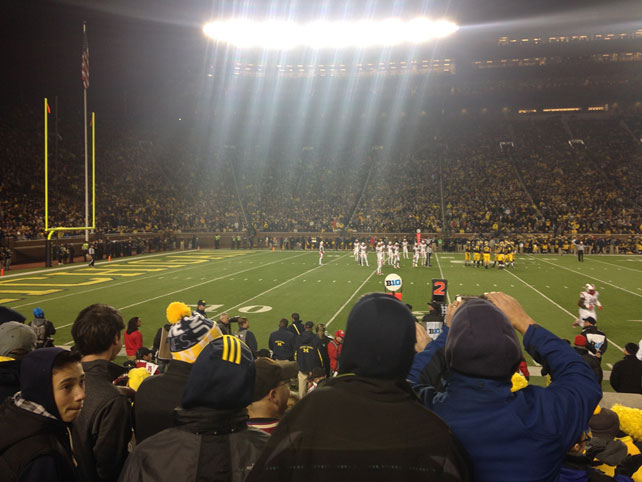
If America were a person, I’d recommend psychiatric help. This was my first thought upon walking into the stadium where one hundred and eight thousand people had gathered to watch college kids playing football. Pure theater. My second thought. I used to play rugby at a decent level for my college. I remember the time we had forty people show up to a game and spoke of it for years to come. Everything is bigger in America.
November 9
I got a look at the Kevorkian papers today. Incredible collection, and something I would not have been able to access without this residency. I didn’t realize Kevorkian was an artist as well as a doctor. As well as a murderer. But was he? Or did he just help desperate people to do something they couldn’t do themselves? His name is certainly whispered as that of some sort of a boogie-man figure, but reading through the letters of his patients, I couldn’t help but feel that he was doing some important work in a controversial way. He was certainly challenging the status quo. Challenging conventional notions of morality. And he certainly had confidence in his convictions. I couldn’t help but like him. But maybe I am romanticizing him. Much much more research is required before I can begin work on anything that is even remotely like Kevorkian, the Musical, as my fevered imagination had already titled the project I had, before today, never even considered working on.
In the afternoon I visit a patient presentation class, which plays out remarkably like a play. We are introduced to the main character, a real life patient, who reminds me slightly of Woody Allen, and then we are invited to re-visit his experience in being diagnosed with a mystery illness. I am trying my best to guess along with the students (incredibly intelligent, all) and, thanks to many many hours of watching medical dramas, I manage (in my head, I don’t dare raise my hand) to follow the case and even make some sensible assumptions. I am struck with an idea that I must speak to Joel Howell (U-M Professor ad doctor) about. Replacing an hour of lectures every term with a play which explores the medical and ethical dilemmas of a specific patient’s case. Sort of like this but more highly dramatized, using actors and performed in a theater (not that type). I need to stop having ideas for things I am not here specifically to work on.
In the evening my mind turns fully to the reason I am here. Interviewing medical students and doctors about their experiences. I am writing a play for the Royal Court Theatre in London, and I think Act Two will be a verbatim piece using the testimonies of said medics and, more specifically, the topic if delivering bad news. It fascinates me as a dramatist that these people spend so much time surrounded by death and yet seem so well-adjusted. Perhaps it is precisely because they spend so much time in and around the thing that the rest of us try to avoid that makes them so well-adjusted. Or perhaps they are not as well-adjusted as I think. As the interviews commence, I realize that it is a combination of the two. It also strikes me that perhaps medical students are the only group of people who think about death as much as artists do.
November 10
What I was finding hard to explain to Officer Crocker is that when I make a piece of theater, I often like to immerse myself in the world so that I can feel more authoritative when I write about it. I have trained as a magician (the show which originally brought me to Ann Arbor and started this whole crazy love affair), a wrestler, and a dancer for shows in the past, and now was the time to experience just a fraction of what medical students and doctors experience by accompanying Dr. Scally on trauma rounds.
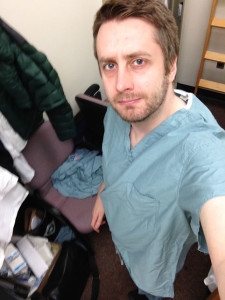
I get up at half-past ridiculous and make my way to the hospital. Which is like a small city. Feeling deeply intimidated and scared, I change into a set of scrubs. You can probably see in the photo below the mixture of fear and tired I was experiencing at this point. And then, as if I had always been a part of the team, as if it was the most natural thing in the world, I accompany two doctors, a resident, and a student (I think I’ve got that right) on rounds. Confidentiality precludes my mentioning anything specific but suffice to say it was an eye opening experience, my major take away being the feeling that doctors absolutely have to develop a dark sense of humor to get them through the day. They have to.
November 12
I have done a few workshops by this point and something that has struck me is that there really is little difference between the artists and the medical students. Whether it be improvisation, writing, or performing, they all enter into it with the same vigor. Both groups offer up insightful and interesting suggestions. Both are equally uncomfortable standing silently in front of the rest of the group. All the workshops are more or less effortless to deliver because the students are so…bright. One group came up with a brilliant play that was set at the top of the Empire State Building during its construction. Four workers on a metal beam, as in that famous photograph. In one-and-a-half hours together we fleshed out this idea, made it real. When I left, one of the students was sitting and writing in the hall. She said she had started writing the play we had just created. I was pleased. I went out and ate some food. Drank far too much beer (Apparently the Hop Cat loves a British accent). And when I came home again around half eleven…She was still there. Still writing.
It might have been the beer, but that made me choke up a little.
November 16
Really getting to know and like the people who are showing me such great hospitality while I am here. The interviews are going so well — getting so much incredible material. The students and doctors alike are amazingly open, to the extent that I am starting to feel guilty about milking them for their stories of misery. However, what has been coming out of this is the understanding that they are anything but miserable despite the fact they are surrounded by so much of it. They are doing a good thing with their lives. The delivery of bad information is not enjoyable, but the fact that they take part in such vital conversations, perhaps the most vital you will ever have, fills many of them with a kind of satisfaction. It’s a privilege. That’s a phrase I’m hearing a lot. It’s a privilege to be trusted with such a sensitive moment in a person’s life. To be sharing something real. Again, a massive similarity between artists and doctors presents itself. We are both looking for something real. We are both searching for truth. In many different ways.
November 17
I had a rip-roaring time at a trivia night last night (the only thing we won was an over-sized Miller Lite T-shirt which my wife is now wearing as a night-gown), but I was a good boy and didn’t drink too much as I knew I had to be up for another set of rounds, this time internal medicine, with Dr. Fine. As the picture below might suggest, this set of rounds did not require me to wear scrubs, so I felt a little less awkward. Again, I was welcomed into the fold as if I was just another medical student. The patients, I realized, didn’t have a clue that I wasn’t some world leading expert in something, which actually made me relax a little bit. Little did they know I was actually a nervous, anxiety ridden, socially awkward wreck. But actually, from the interviews I have conducted, I have come to realize that this is the normal way for a student to feel in a hospital.

These rounds are different. Less immediate danger. But more emotional somehow as the patients stories can be delved into in more detail. I come out feeling my respect for doctors deepen still. Dr. Fine genuinely cares about his patients. He cares not only about making them physically better but making sure they are emotionally cared for.
November 18
Another session with the Kevorkian papers is followed by my last workshop. We seem to save the best for last as together we come up with a concept for a play and create another world in an hour-and-a-half. This is the story of a young offender in prison. The twist is we never see her face. We only hear her voice and we learn about her through the visitors she receives. A really genuinely exciting concept created from nothing and fleshed out with characters, a plot line, and a question we collectively try to answer. What Price Truth? I’ve capitalized that question because it also works as the title. What is the truth worth? Should the girl lie for a reduced sentence or keep telling the truth and get life? Should we tell the difficult truths or lie for an easier life?
This cuts to the heart of the play I am working on for the Court. How do you tell someone they are going to die? Do you sugar coat or do you tell them the cold hard truth? Is it ever right to withhold information from a patient to spare their feelings? What Price Truth?
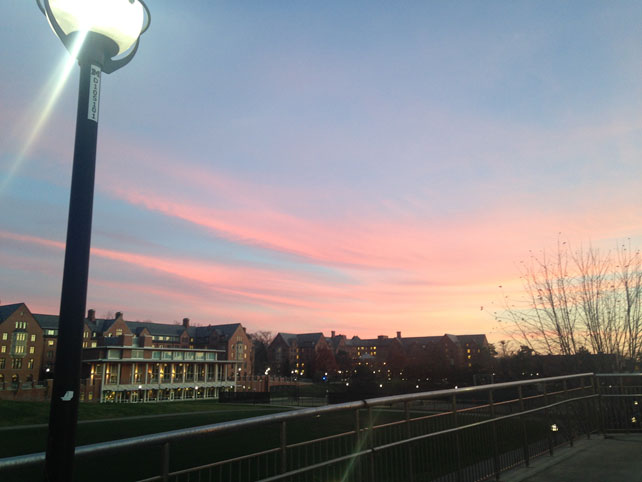
A good way to end my stay.
November 19
I left Michigan yesterday evening. And now I’m going through customs at Glasg-. Oh. I’m through. He barely looked at my passport. The joys of returning to your home country as a national. On my way though, I see a passenger has been taken aside (we don’t have the budget for a whole room apparently) and is being questioned. He doesn’t speak much English – he’s dark-skinned, possibly Indian, I’m not sure. The difference? This time the border control people are smiling. Joking with him. Trying to put him at ease. We’ll get this sorted. Don’t worry.
You see that Officer Crocker. That’s how you do it.
Rob Drummond is a writer, performer and director from Glasgow. His theater credits include Sixteen (Arches Theatre Festival), Hunter (National Theatre of Scotland and Frantic Assembly), Mr Write (Tron Theatre and the National Theatre of Scotland), and Rob Drummond: Wrestling (The Arches, winner of a Vital Spark Award), among others.
UMS/New York Philharmonic Residency: By the Numbers
UMS’s residency with the New York Philharmonic in October 2015 touched unprecedented numbers of people through performances, master classes, educational activities, and the halftime show at the U-M Homecoming Football game against Northwestern.
A highlight reel of the weekend’s activities:
Performances
The New York Philharmonic gave performances of three different programs in Hill Auditorium October 9-11, 2015. Total attendance was 7,945 across all three performances . First-time UMS ticketbuyers accounted for 38% of the total audience. Attendees came from 37 states plus the District of Columbia, and from 8 foreign countries.
Student Attendance
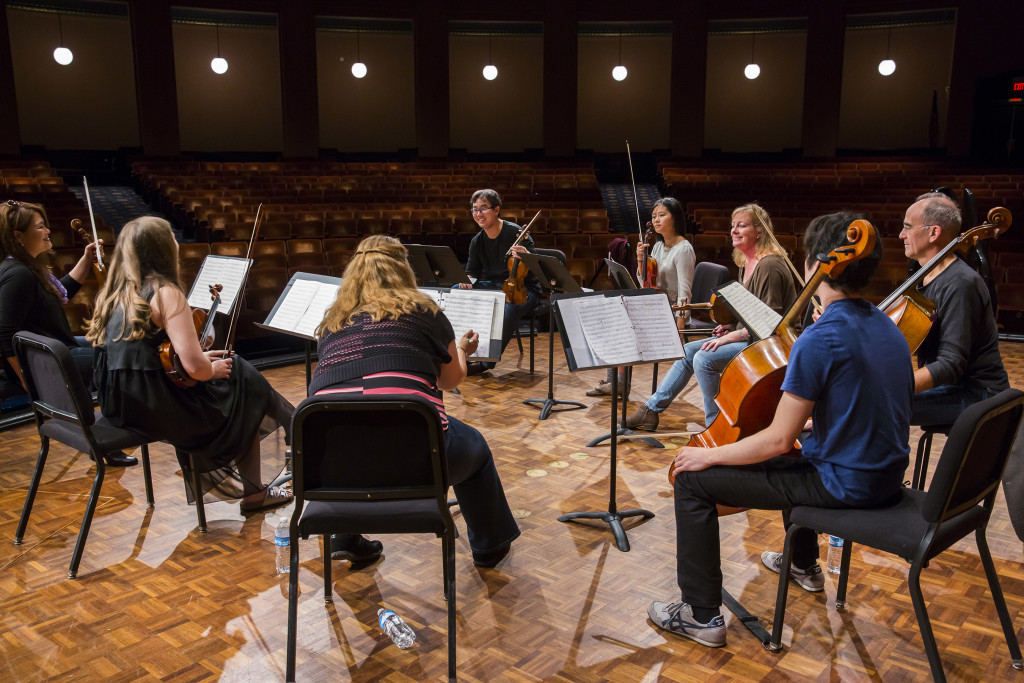
New York Philharmonic at Univeristy of Michigan, Ann Arbor Residency, 10/08/15. Photo by Chris Lee
Students purchased more than 2,250 tickets at a significant discount and accounted for nearly 30% of paid attendance. UMS subsidized over $110,000 in discounted tickets for students. In addition, students accounted for an estimated 75% of those attending the various residency activities over the course of the multi-day residency.
Residency Activities
As part of the multi-day residency, members of the New York Philharmonic participated in 36 additional public and private activities, including lectures by various Philharmonic staff (5); a side-by-side chamber music concert (and rehearsal) in which New York Philharmonic principal musicians played alongside U-M School of Music, Theatre & Dance graduate students (2); classroom visits (5); master classes and conducting roundtables (17); visits to three Ann Arbor high schools (4); an event pairing medical students with Philharmonic musicians (1); an open rehearsal for conducting students (1); and performing at the U-M Hospital as part of the Gifts of Art program (1). The total reach of these activities was 2,495.
In addition, UMS selected U-M student and percussion major Evan Saddler as part of its 21st Century Arts Internship program, and he was placed as an intern with the New York Philharmonic for the summer leading up to the residency. He writes about his experiences on this blog.
Half-time with the New York Philharmonic Brass and the U-M Marching Band

New York Philharmonic at Univeristy of Michigan, Ann Arbor Residency, 10/10/15. Photo by Chris Lee
One of the highlights of the residency was the inclusion of the New York Philharmonic brass section in the University of Michigan Homecoming Football game halftime show, along with the U-M Marching Band, the U-M Alumni Band (a Homecoming tradition), and the UMS Choral Union. Alan Gilbert conducted the 1,000+ musicians in selections from Aida, Bolero, Carmen, Beethoven’s Ninth Symphony, and other works. Total game attendance was 110,452, and the video of the halftime show has received tens of thousands of additional views.
The “digital Big House” resulted in nearly 200,000 people engaged through social media platforms, including Facebook, Twitter, Instagram, and umslobby.org. The 9 videos that UMS produced during the course of the residency received almost 50,000 views over the course of the weekend.
Eugene M. Grant
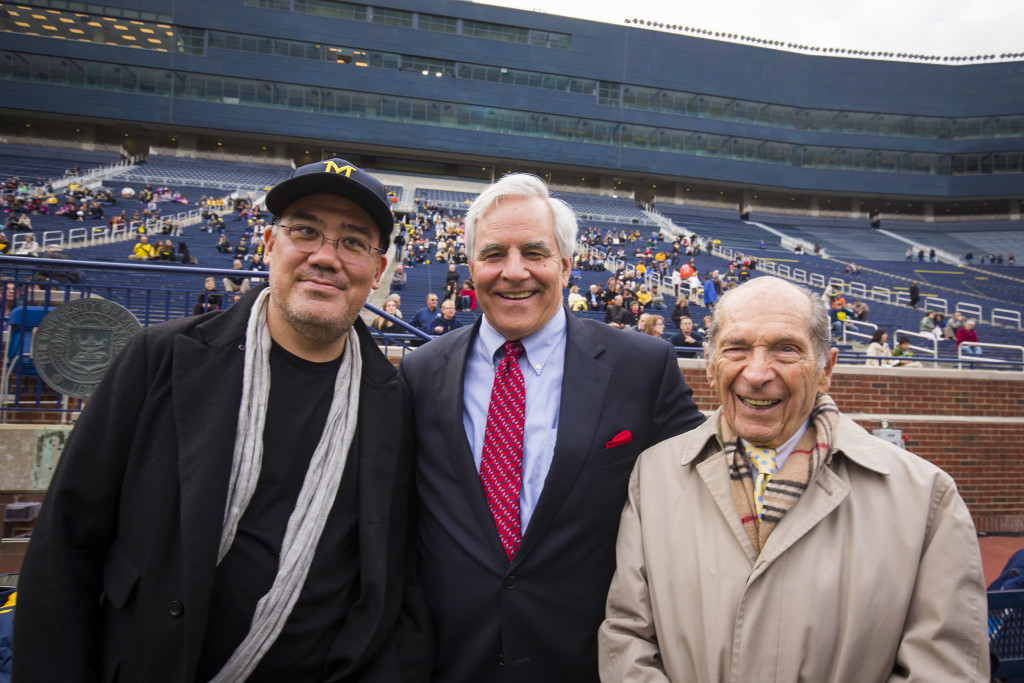
New York Philharmonic at Univeristy of Michigan, Ann Arbor Residency, 10/09/15. Photo by Chris Lee
The New York Philharmonic residency marked the first gift of $1,000,000 to UMS, from UMS National Council member Eugene M. Grant (’38, LSA). At 97, Mr. Grant came to Ann Arbor for the weekend’s activities and called it “one of the most memorable events of the past four decades.” Mr. Grant was celebrated at a special “Victors for the Arts” gala dinner on Thursday, October 8 on the stage of Hill Auditorium.
Members of the media interested in more information about the program should contact Sara Billmann, UMS Director of Marketing & Communications, at sarabill@umich.edu.
Highlights from the Field
On October 10, musicians of the New York Philharmonic took to the football field along side the U-M Marching Band at the Michigan vs. Northwestern Homecoming game.

Three concerts and a slew of activities were a part of the residency, which is part of a five-year partnership with the orchestra.
Interested in more? Watch the full halftime show over at U-M Athletics.
At the Victors for Arts Gala

Scenes from our Victors for Michigan gala dinner, a special event kicking off a weekend of concerts and residency activities with New York Philharmonic.
In center photo, UMS president Ken Fischer (left), University of Michigan president Mark Schlissel (right), and Eugene Grant, whose $1 million gift makes the residency possible.
Interested in more? Explore the full range of residency events and activities.
Free Public Events with the Merce Cunningham Dance Co. This Week
Each year, we have a chance to get to know some of the artists on the UMS season a little better. We hope you’ll join us this week for any of the free public residency events with the Merce Cunningham Dance Company:
Evolution of a Brand: Merce Cunningham Dance Company
TONIGHT! Mon, Feb 14, 5 pm
U-M Ross School of Business R1220 (701 Tappan)
MCDC Executive Director Trevor Carlson leads a discussion with UM business school students on the development, maturation, and end of a well-known brand; the legacy of the company’s identity and how the brand will live on; and what we can learn from this process about problem-solving and leadership.
A collaboration with Ross Leadership Initiative
A Lifetime of Creativity: Merce Cunningham and Defying Limitations
Wed, Feb 16, 6 pm
Helmut Stern Auditorium, UMMA (525 S. State St.)
Panel discussion on the changes in creative process throughout the life of an artist with Trevor Carlson, MCDC Executive Director; David Vaughn, MCDC Archivist; Christine Bratton, MCDC Physical Therapist; UM Professor Nicholas Delbanco who tackles the enigma of “Lastingness” over a creative life in his new book of the same title; and Professor Joel Howell, MD who will address the physical changes inherent in the aging process.
A collaboration with UMMA, U-M Department of English Language & Literature, and the U-M Health System
A Lifetime of Inspiration: U-M Dance Student Responses to Merce’s Story
Thu, Feb 17, 7 pm
Betty Pease Dance Studio A (1310 N. University Ct.)
U-M Dance Students create solo work in response to Merce Cunningham’s “A Lifetime of Dance” film, and perform works for current company members. Current company members then each tell a story about their performing life with Merce.
A collaboration with U-M School of Music, Theatre & Dance
“Dance by Chance” Audience Warm-Up
Fri-Sat, Feb 18-19, 7 pm
U-M Alumni Center
Free pre-performance warm-up, open to MCDC ticket-holders. Learn about Merce Cunningham’s choreographic process, and how he used “chance operations” in his work. Then try the process yourself in a pre-performance chance operations warm-up for the audience facilitated by MCDC Company Manager Kevin Taylor.
Post-Performance Q & A:
Merce Cunningham Dance Company
Friday, February 18
Power Center
Members of the Merce Cunnigham Dance Company discuss their performance and take questions from the audience. Must have a ticket to attend.
Keepin’ up with the Joneses: BTJAZ Dance Co. in Residence
When asked to write this blog, I have to admit, I was more than a little anxious. I was stoked but I couldn’t shake the unnerving feeling about doing something way outside the job description. I was handed the opportunity to leave my usual post in the UMS Ticket Office to work closer than I ever have with our artists. I was to follow the Bill T. Jones/Arnie Zane Dance Company during their educational residency with UMS.
Day One: Masterclass at Dance Theater Studio, Ann Arbor
As I climbed the stairs to the studio I saw that BTJAZ Dance Company Education Director Leah Cox and dancer Talli Jackson had already arrived. About 15 high school ballet dancers streamed into the studio excited for a change from their usual routine. In the beginning half of class, Leah and Talli led an exploration of movement, Bill T. style. Leah had the class move through different levels and space stressing the importance of creating movement that is aware, yet unrestrained. The idea is that, in dance, your mind is as much of an active participant as your body. In actively engaging both you can evoke dance based on specific ideals, like the girls later learned through creating dance inspired by their own heroes. It was amazing to see Leah communicate this idea to the teen dancers, who then translated this concept in their own original movements. The same process was used to create Fondly Do We Hope…Fervently Do We Pray, the piece the Bill T. Jones/Arnie Zane Dance Co. would perform later that week. Check out my video clip and see the Dance Theater Studio class at work.
So We Think You Can Dance, Dance Workshop for the Ann Arbor Community
After watching the first master class, I was hooked. So, that evening, instead of observing the community dance workshop, So We Think You Can Dance, at the Ann Arbor YMCA I decided I had to participate—Yikes!! As a novice dancer, I was comforted to see the wide range of participants brave enough to explore movement with me, and as an UMS staffer I was proud to see such a fantastic turnout! Leah eased into the class with a warm-up called the developmental patterns. While we breathed, curled, and twisted, Leah explained that through these movements we were reprogramming our bodies, reteaching ourselves to create movement, not as coordination, but as what we do naturally as human beings. We then paired off to discover new shapes. While impulsively traveling through space from shape to shape, I reminded myself to maintain awareness of how my body was moving. Was it as effortless or beautiful as Leah and Talli made it look? I’ll leave you to decide…
Day Two: Detroit’s Paul Robeson Academy and Cass Tech High School
The afternoon spent visiting Paul Robeson Academy and Cass Tech High School was memorable and eye opening for me. We’ve all heard about the financial state of the Detroit Public School system and the bad rap the schools generally receive. In spite of the obvious need for more resources and more classroom space, I couldn’t help but notice the excitement of the students at Paul Robeson Academy or the youthful talent of the Cass Tech students. What I thought was just an ordinary day at these schools changed when I saw how eagerly the students received Leah and Talli. After watching the students’ earnest participation during the workshops, I felt really privileged to be part of their learning experience with the arts. I’m sure Leah and Talli felt just the same.
Day Three: Penny W. Stamps Distinguish Speakers Series, Michigan Theater
As the performance date of Fondly Do We Hope…Fervently Do We Pray neared I began to wonder, what kind of man is Bill T. Jones? Sure, I knew his methods behind creating the piece but what were his intentions, his message? Fingers crossed and eager to find out more, I went to his lecture–part of the Penny Stamps Distinguished Speakers Series–in the Michigan Theater. Bill spoke to a full house and shared his philosophy on movement, the words of Abraham Lincoln and Walt Whitman, as well as excerpts from the performance. He described his own personal relationship to Lincoln as having evolved. Starting with a child’s unconditional love for a legendary figure, torn down in young adulthood to a man he abhorred, and settling as a hero and inspiration as an adult. Losing faith in our childhood heroes is easy enough to understand, and Bill’s new vision of Lincoln was an inspiration. By the end of the lecture Bill asked us to examine his work as pieces of a puzzle, fit them together as we will, and invited us to reclaim Lincoln. I decided that Bill was prodding us to perceive every motion, every song, even everyday life, and then, ultimately, encouraging us to determine reality on our own terms.
I’d like to say I left that lecture with more answers than questions. Yet, even after the workshops, lectures, the Q & As, and performances, I still find myself stirring from the music and movement of Fondly Do We Hope…Fervently Do We Pray. Following the Bill T. Jones/Arnie Zane Dance Company’s residency with UMS was such a rewarding endeavor for me personally because I was able to see another side of UMS. My daily interactions with the artists coming through UMS’ auspices are limited to the mentioning of their names over the phone. After spending the week attending the residency events I was not only amazed at the number of educational opportunities planned to connect with artists and enrich the community, but also at how invested I had became inthe residency overall.
For more photos from the events I’ve mentioned as well as other events including the BTJAZ Dance Co. Youth Performance and masterclasses with Wayne State University and University of Michigan please check out my slideshow.





























